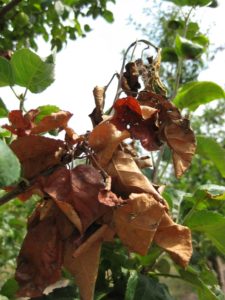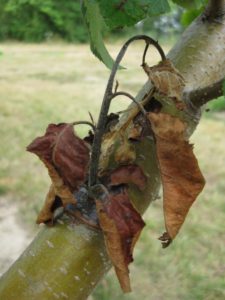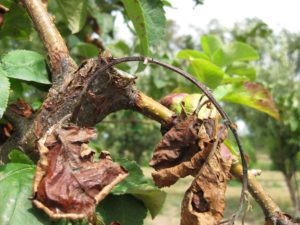Fire blight, caused by the bacterium Erwinia amylovora, is a devastating disease of apples and pears. Epidemics of the disease develop quickly, particularly in a climate of warm, wet weather, with hail events—like last night’s 0.75” to 1.5” hail! The type of management program developed by each orchard will vary considerably based upon a variety of orchard factors, including apple variety, rootstock, age of planting, and weather conditions. With the current extreme weather events, a review of fire blight seems timely.
At this point in the season, we have passed through the blossom blight period, but I haven’t heard of any reports of fire blight. Early spring weather conditions were not conducive to blight infection due to the cool, dry weather. This means that any observed infection came from damage from the previous year. This shoot blight probably developed from the long wet spring/summer that prevented growth from hardening off, or even the hail and severe wind damage from some of the incredible storms that have blown through our region (trauma blight). After last night’s event, it is important to continue to scout!
Often times, the first symptoms of infection are shoot blight. Shoot blight usually develops in late spring or early summer, when the bacteria moves from infected flower spurs into the tree. Soon, this new growth on the infected branch begins to wilt and becomes shoot blight. Shoot blight can develop rapidly under favorable conditions; as young shoots wilt and die, bacterial ooze may be visible. Blighted shoots will often form the characteristic “shepard’s crook” at their tip.
When infection is severe, the appearance of blighted shoots gives the impression that the tree (particularly pear) has been scorched by fire, hence the name fire blight. Canker blight forms when the bacteria causing shoot blight spread from the new green tissue of the shoot into the woody tissue of the tree.
The cankers appear sunken and dark and, when the outer bark is cut away the underlying tissue may appear water soaked. Preventing the development these cankers is important, as these are the main areas where the bacteria overwinter. These cankers are always associated with shoots that were killed last year.
Regular scouting is essential for effective fire blight management. Many popular varieties (Gala, Silken, Ambrosia, Fuji, Braeburn) are very susceptible to fire blight. The question remains as to whether you should prune immediately after blossom infection, or wait until the trees are dormant. Previously, management recommendations were to prune out infections as soon as they were observed. One group in Israel tested this on pears (Shtienberg, D. et al.. 2003. “New considerations for pruning in management of fire blight in pears.” Plant Dis. 87:1083-1088.), and the results of these tests show that other factors profoundly affect the time of pruning, and affect the success of pruning and its contribution to tree health.
So, what is the how and the when that affects fire blight? They found that how the plant is growing (i.e., health and vigor) and when the growth is occurring [called the phenological status of the host (i.e., bloom, pink, petal fall, etc.)] are factors that affect success in fire blight pruning management. Because of these factors, there are situations in which pruning can be expected to improve tree health, but there are also cases in which pruning would make no difference, as the disease would not endanger the host plants if left untouched. Furthermore, it was found that sometimes it was preferable not to cut at all, because pruning affected tree health negatively. So, the question still remains: To cut, or not to cut? And if so, when to cut?
These researcher found that when pruning was carried out as recommended to growers (that is, using disinfected tools and making the cuts in a healthy area approximately 12” below the site of infection), pruning did not result in successful eradication of the pathogen.
This could be due to several reasons, including that the fire blight bacteria infected tissues beyond the sites of visible symptoms, and even beyond the cuts into “healthy” appearing tissue 12” away. The fact that the bacteria spread beyond the 12” pruning cut is not too surprising and may explain why pruning did not successfully eradicate the pathogen from treated trees. It is also possible that despite the fact that the pruning tools were disinfected with bleach between cuts, not all of the bacteria were killed and colonized the cut stubs. Last but not least, it is possible that the bacteria invaded the host tissues directly through the new wounds created during pruning the ugly stub in the first place!
Regardless of what happened, the fact remains that pruning out fire blight was not successful in eradicating the bacteria from most treated trees. These researchers found that the effectiveness of cutting and removing infected branches and limbs was directly related to time of treatment: That is, pruning worked best the later in the season it was performed, and the best results were obtained when pruning was carried out while the trees were dormant. None of these dormant-pruned trees had a severely infected canopy the following spring.
Obviously, postponing the cutting of fire blight–infected tissues to winter may create two problems. First, the bacteria may continue to progress in the infected tissues and result in greater damage; ad second, the problem caused by delayed cutting is that infected tissues may serve as an active source of inoculum that could endanger the entire orchard. What needs to be remembered is that the blossoms are most susceptible to the bacteria; assuming that there are no rat-tail or autumn blossoms, and in the absence of a hail event, the probability of secondary infections in orchards is minimal. Where off-season blossoms are apparent, special care should be taken to prevent their infection.
Using this current information, growers need to distinguish between situations in which the disease is detected on blossom clusters, succulent shoots, or lateral branches, versus first detected on main branches and limbs. In the first situation, growers are advised to make a distinction between spring and autumn infections. In the spring, recommendations are not to touch trees with limited growth vigor. On these trees, fire blight infections are likely to be restricted to the spurs and not to invade the main branches of the trees. Cutting these infections off, if it did not successfully eradicate the bacteria from the trees, could make the situation worse. If trees with vigorous growth are infected, growers need to differentiate between those bearing few and those bearing numerous infections. With limited infections, growers should eradicate the infections by cutting back to a healthy section of the plant, about 20-25” from the site of visual symptoms. If numerous infections are observed on vigorous trees, the experience from this study suggests that the eradication efforts will likely be unsuccessful and may even make situation worse. Thus, to minimize unsuccessful pruning efforts, growers should postpone the pruning until winter. In these cases, the infections limbs and branches should be marked with colored paint so growers know what to prune in the late winter when the plants are dormant.
Trees that repeatedly show symptoms of fire blight (more than three years in a row) should probably be removed and burned. I say this for three reasons: First, continuous pruning of the same infected trees year after year is not sustainable; Second, the repeating infection indicates that the tree is systemically infected, and third, this tree now serves as a reservoir for additional infections. In this scenario, you are best advised to literally “cut your losses” and prune at ground level.
Finally, unless you are still at bloom, streptomycin use is not recommended. Its efficacy (along with the plant growth regulator, Apogee) is restricted to use at bloom, followed up once or twice through petal fall. No antibiotic is recommended for trauma blight. In Indiana, where there are no reports of streptomycin resistant fire blight bacteria, there is no need to use any other antibiotic.


